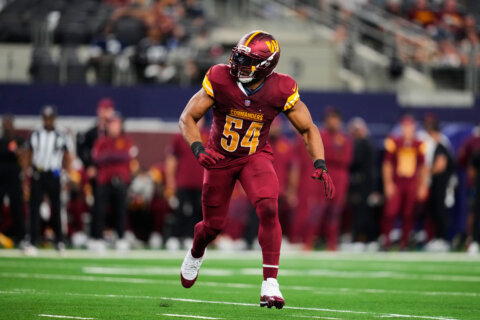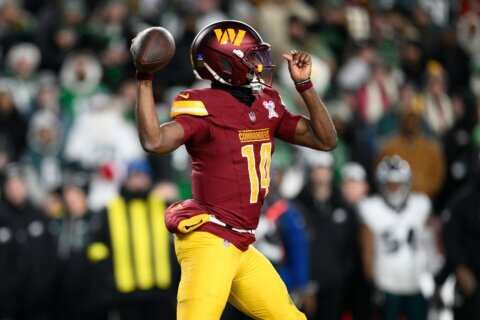McLaurin, who used to dislike slants, now routinely wins on them originally appeared on NBC Sports Washington
Terry McLaurin, believe it or not, used to be a bit picky as a receiver.
As McLaurin explained in the Commanders locker room on Thursday, he preferred running “all the deep stuff” during his time at Ohio State. Posts, double moves, straight-up gos — those were his flashy favorites.
“I was just a vertical threat,” he recalled.
But since joining Washington in 2019, McLaurin has strived to develop into a more complete wideout, and that process has pushed him to thrive on a route he once thought little of: the slant.
“Being in the NFL, some changes at quarterback here and there, I’ve had to get a lot better in the short-area route running,” McLaurin said when asked about his growth on slants. “Now I feel like it’s a very strong part of my game.”
The Eagles would likely agree with that assessment, seeing as McLaurin consistently freed himself up by bursting off the line of scrimmage and then quickly cutting inside this past Monday at Lincoln Financial Field.
Washington Football Talk Podcast | Listen and Follow | Watch on YouTube
On a third-and-8 early in the second quarter of the Commanders’ stunning win, McLaurin and Taylor Heinicke connected on a slant to move the chains on the way to a Joey Slye field goal.
Then, just before the two-minute warning, McLaurin hauled in another one for nine yards on a third-and-10, which set up a short fourth-down chance for his offense and eventually contributed to a Brian Robinson Jr. touchdown.
And in the third quarter, McLaurin gained 11 yards on a second-and-12, which again put the group in position to convert on a gettable key down and ultimately helped produce another Slye field goal.
On each, McLaurin displayed suddenness that left no question as to how he found freedom despite being so focused on.
“That’s one of the best routes he runs,” Heinicke said Wednesday about his top target. “I’m very comfortable with him in doing that. We have a lot of reps at it.”
“Somehow, some way, he’s going to catch it,” coordinator Scott Turner told reporters on Thursday regarding McLaurin’s slant prowess. “There’s a high level of confidence that I have that he’s going to end up with the ball at the end of it.”
With the depth they’re designed for and the frequency that they’re called across the sport, slants could be mistaken as an easy pattern to pull off. But while the completion percentage on them is inevitably greater than throws that travel further downfield, McLaurin still believes slants can act as a differentiator among pass catchers.
“I think you see the difference between receivers who are good and great,” McLaurin said.
McLaurin described having to execute a slant versus a defender who’s already using inside leverage as an example for why he thinks that. In those spots, the opponent has an edge because he’s aligned pre-snap on the track that the skill player wants to follow. Only the best on offense can succeed in such a scenario, per McLaurin — and he often does.
McLaurin also touched on the matter of what one does after getting possession on a slant. If the quarterback’s accuracy is there, then bonus yardage should come, too.
“I feel like I’m strong enough to be able to break some of those tackles and make those 5-yard slants into 8-to-10 yard gains,” he said.
Ron Rivera concurs.
“He’s a lot more stout I think than people realize,” Rivera said. “He’s got a stout toughness about him.”
“He’s got this acceleration that if he splits it, he can go,” the coach added.
Lastly, slants can act as a building block for other routes — you know, the kinds that McLaurin had a fondness for in school. If McLaurin’s in a groove on them, then those assigned to him face no choice but to creep up in their coverage, which increases the space behind them that McLaurin can proceed to utilize. In Philadelphia, for instance, McLaurin’s 41-yard snag against Darius Slay occurred after the three slants outlined above.
Of course, McLaurin — who’s eighth in the league in receiving yards — is pretty potent regardless of the route he’s asked to handle. His speed and reliable hands mean he could likely find an opening on a shoeless, in-and-out comeback post where one of his gloves is covered in motor oil.
“You want to mix it up,” Turner said. “Terry can do it all.”
The slant, however, highlights what makes McLaurin so special overall and why Washington is so fortunate to feature him: When he notices a deficiency, he grinds on it until it’s an asset.
“It wasn’t my favorite,” he said, “but now it’s definitely up there.”







